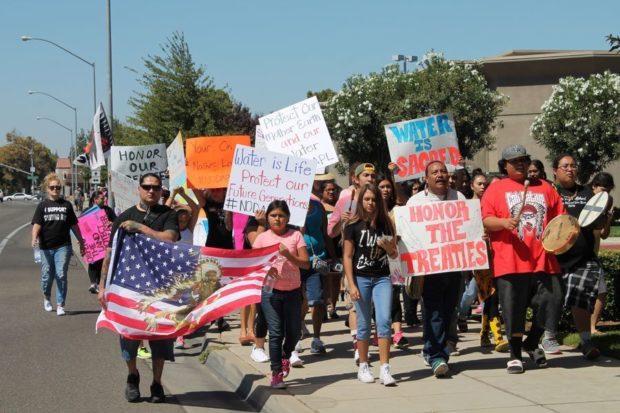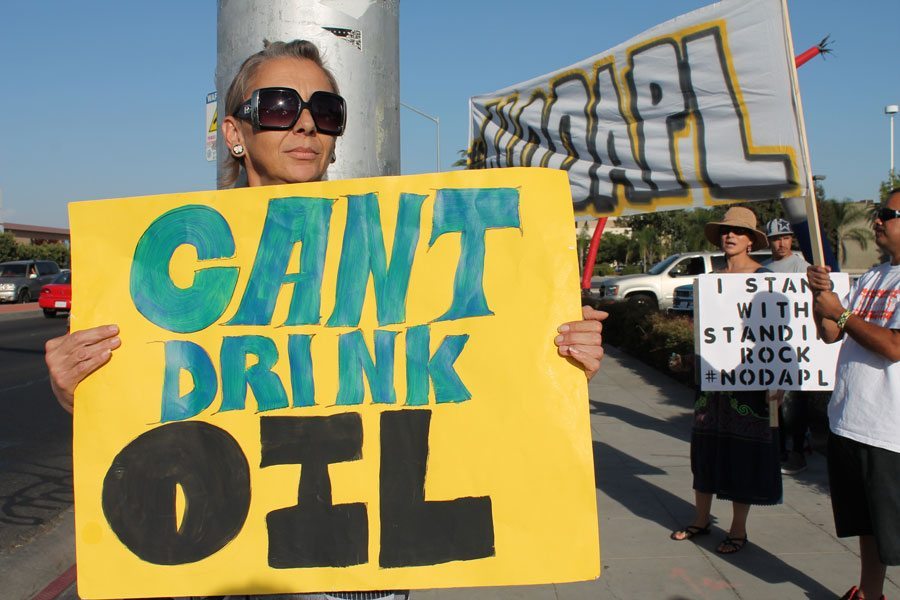
By Hannah Brandt
One of the largest demonstrations by indigenous peoples in recent U.S. history has been taking place in North Dakota over the last several weeks. The activists prefer to be called protectors, rather than protesters. Hundreds of tribes and supporters from around the U.S. have gathered in Cannonball, North Dakota to protest the construction of a 1,172-mile pipeline from North Dakota to Illinois that would deliver 470,000 barrels of crude oil daily near the Standing Rock Sioux reservation. The pipeline would flow under the Missouri River, adjacent to Lake Oahe, just upstream from the Sioux land, endangering the tribe’s drinking water and potentially desecrating ancient sacred sites. Tribal leaders say “It’s not a question of if there is a leak, but when.”
Native people have come from as far away as Hawaii and include indigenous people of Mexican heritage. They are camped out to protect the Sioux land and speak out against the potential environmental and cultural destruction. In addition to protecting the land from the pipeline already under construction, leaders say they are demanding a seat at the table in decision-making going forward. The tribe says it was never consulted on the issue before the company rolled in their heavy equipment. According to Earthjustice, the environmental law firm representing the Standing Rock Sioux, the Army Corps of Engineers violated the National Historic Preservation Act when it approved the project and a more stringent environmental review should be done.”
While it is the biggest, this is not the first action by Native Americans against oil pipelines on or near their lands. The Keystone XL pipeline which was set to run through several Midwestern states also prompted members of various groups including the Sioux, Lakota, Dakota, Assiniboine, Ponca, Cree, and Dene to speak out. In November of 2015, President Obama denied the cross-border permit for the Keystone XL. Building on that victory, indigenous groups are standing firmly together against the Dakota Access Pipeline. Like with Keystone, non-native citizens have also denounced the environmental impact of the Dakota Access pipeline. Non-native farmers in the area pushed back and prevented the pipeline from being built on or near their land. The oil company, Dakota Access LLC, then bought up land all around the tribal land, including sacred ancestral land not on the Standing Rock Sioux reservation.

In August, state government officials cut off water to the camps, including tanks and pumps to trailers for what they called non-peaceful protests. The North Dakota Department of Health brought in supplies to help offset that. On September 9, a judge ruled to allow the Dakota Access pipeline construction, but immediately afterward the U.S. Department of the Interior, The Justice Department and the Department of the Army (which oversees the Army Corps of Engineers) issued a statement to temporarily halt the construction. Five activists were arrested on September 27 for blocking a road.
The peaceful protection actions have been met by violence from the pipeline company, Dakota Access LLC. Democracy Now! footage from September 3 showed private security deployed pepper spray and allowed their guard dogs to attack Native Americans standing together to prevent pipeline construction machinery access. Afterward, people displayed bite marks and the dogs had blood on their snouts. A warrant was issued for Democracy Now! journalist Amy Goodman’s arrest. At the time, the news organization was the only media on site. Green Party presidential candidate Jill Stein was also arrested for her part in the demonstration. None of the security personnel were charged for the attacks on demonstrators.
In addition to the land protection demonstrations in North Dakota, supporters around the country have held solidarity rallies in various U.S. cities, including Fresno. Community Alliance photographer Richard D. Iyall, Cowlitz attended the Dakota Access Awareness Walk held on September 4. His account is relayed below.
“My photos cover the gathering of people at River Park, with the walk along Nees Avenue eastward, then to the highway 41 overpass. The group stopped there in the shade and played drums, including a song that was sung in the language of the Standing Rock Sioux. As the group crossed Nees Avenue at Blackstone, with people holding signs, drumming and singing together, a woman who was holding up a bottle of water at the corner declared “You can’t drink oil!”
After the first group, including those drumming and singing came to the underpass, more people came, including those who were chanting “Can’t Drink Oil. Water is Life”. Among the people who followed that group was a woman holding a sign that read “NO DAPL,” She told me her name was Carla and that she was there from Oakland.
At the underpass, after the people completed their drumming, singing and chanting, I contacted event organizer Josephine Fuentez Green and showed her a copy of the September issue of the Community Alliance with my poem: “I Am Indigenous”. I told her that I could recite it for the people. She said that right then would be the time to do it. Two to three dozen people were gathered around in a circle, with other people outside the circle. I had put some copies of the Community Alliance on a table. I told the people about the poem in the paper and started to recite the poem. Then someone suggested I use the bull horn. So I got it and started to recite the poem with it. Someone suggested that I face the underpass graded berm to get the sound to bounce off of it. So I did that and completed the recital of my poem.”
As this story develops, Community Alliance will have more coverage of the events.
*****
Hannah Brandt is the editor of Community Alliance newspaper. You can follow her on Twitter and Instagram at @HannahBP2. Follow the paper on Facebook at Community Alliance Newspaper and on Twitter and Instagram @fresnoalliance. Richard D. Iyall is the Community Alliance newspaper photographer. Contact him at richarddiyall@yahoo.com.
